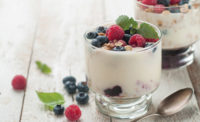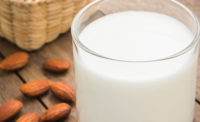
Source: Dreyer’s Grand Ice Cream, Inc.
I won’t name brands or even ingredients, but I must bring to your attention a new product I observed at the Sweets & Snacks Expo this week in Chicago. It’s a sugar-free lollipop that makes the following claims: “high in fiber,” “100% Daily Value of vitamin C” and “reduced calorie.” I know enriching foods with fiber and other nutrients is becoming increasingly popular, but adding fiber to a lollipop, that just does not seem right. Regardless, product developers should understand that the science of fiber food ingredients continues to evolve, with more benefits being discovered and additional sources identified. And as a result, the fiber-enriched food and beverage market is booming, and dairy foods have been identified as an ideal carrier for fiber food ingredients…not lollipops!
Do you know your fiber food ingredient options?
Historically the terms “soluble” and “insoluble” have been used to classify the specific type of fiber on food labels, in scientific research and in nutrition education efforts with consumers. These terms continue to be used in these industries; however, most fiber authorities would agree that the terms are outdated and do not accurately represent the evolving fiber food ingredient industry. For example, some of the health benefits of fiber are related to solubility, but others are not. Instead, viscosity and fermentability might be more meaningful terms to differentiate.
However, for now, in the United States, the terms soluble and insoluble remain in fiber vernacular. In fact, FDA has made it optional for marketers to break out a food’s fiber content by soluble and insoluble fiber content.
What is soluble fiber?
Soluble fibers are described as being soluble in water. They absorb water and, in doing so, form a gel. Soluble fiber food ingredients include beta-glucan, fructooligosaccharides (FOS), galactooligosaccharides (GOS), gums, inulin, pectin, polydextrose, psyllium, some hemicelluloses and resistant maltodextrin.
Historically soluble fibers have been described as forming viscous solutions, and are recognized for their ability to trap dietary cholesterol and bile acids as they pass through the gastrointestinal tract. This helps the body eliminate cholesterol and reduce blood cholesterol levels, and thus reduces the risk of heart disease.
This viscous solution has also been shown to trap carbohydrates, slowing their digestion and absorption. This may help prevent wide swings in blood sugar levels during the day, as well as have an impact on the development of adult-onset diabetes.
Some soluble fibers such as inulin, FOS and GOS, do not produce viscous solutions, which is why many authorities would like to eliminate the use of the descriptor soluble. These fibers do not reduce blood lipids or reduce blood glucose like traditional soluble fibers such as beta-glucan, gums, pectins and psyllium. Most non-viscous fibers have been shown to boost calcium absorption and are fermentable, thus acting as prebiotics to promote the growth of beneficial intestinal bacteria known as probiotics.
Many soluble fiber food ingredients are obtained directly from vegetation using some physical processing. Others are synthesized, or obtained through the use of chemical and physical processing. The latter includes polydextrose and resistant maltodextrin, as well as insoluble cellulose that has been modified to become soluble. This includes, but is not limited to cellulose gum, also known as carboxymethylcellulose, hydroxypropylmethylcellulose and methylcellulose.

Source: Gum Technology Corp.
If soluble fibers are soluble in water, I bet you can guess what characterizes fiber food ingredients classified as insoluble. Insoluble fiber food ingredients do not form viscous solutions either. The most common insoluble fiber food ingredients are lignin, cellulose and some hemicelluloses. Vegetables and cereal grains are especially rich in insoluble fiber, with the highest amounts in wheat and corn.
Insoluble fiber is associated with reducing the risk of digestive disorders, as well as certain cancers. With cancer, the exact mechanism is unknown, but scientists theorize that insoluble fiber adds bulk to stool, which in turn dilutes carcinogens and speeds transit through the lower intestines and out of the body. This same process of bulking stool hastens passage of fecal material through the gut, thus helping to prevent or alleviate constipation.
Traditionally, insoluble fiber food ingredients have been used in the grain-based foods industry, where they are more compatible with the sensory characteristics of breads, cereals and muffins. Only a few insoluble fiber food ingredients are adapted for non-grain applications, where flavor, color, body and texture are quite subtle.
OK, so what is resistant starch?
There’s an exception to every rule…and in the fiber food ingredients business that exception is resistant starch, which is insoluble in water, yet is fermented like a soluble fiber.

Source: National Starch Food Innovation
When deciding on fiber food ingredient(s) to add to dairy to boost fiber content, one must consider the marketing/claim goal? Is addition simply to make a content claim, or is the goal to make a structure-function claim? For example, a number of fiber food ingredients possess clinically proven prebiotic benefits. However, marketers often do not tout these benefits on marketing materials because many consumers just don’t seem to understand the role of prebiotics in health and wellness. A marketer must decide if adding the prebiotic, without making a claim, still benefits the ingredient statement-reading consumer who understands the health and wellness attributes of different fiber food ingredients.
Whatever your objective, adding fiber food ingredients to dairy foods makes sense. Now lollipops…that’s another story!


